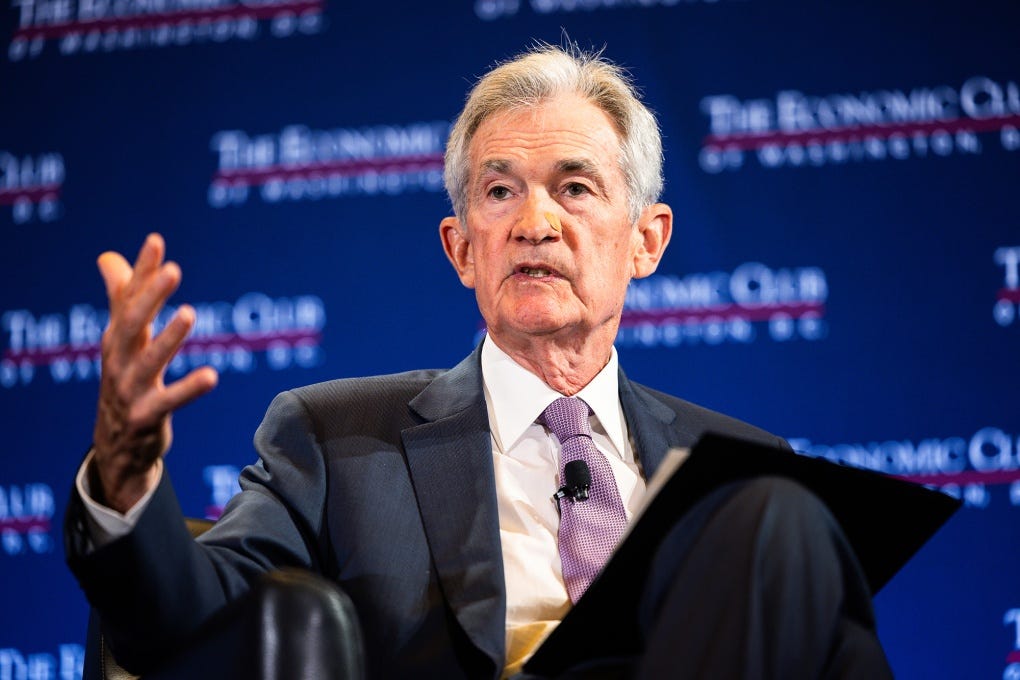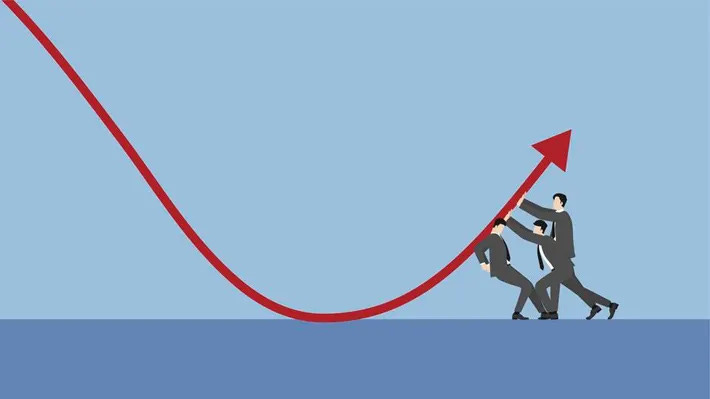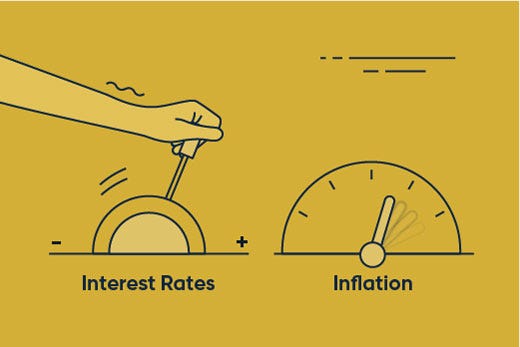Newsletter #4
Featuring stories about: high Inflation, cooling economies, antitrust laws, and more!
Dear Reader,
Welcome back to the fourth edition of The Economic Literacy Initiative Newsletter. As always, you will find insights on current economic events. You may have noticed that we moved to Substack, to help give us more availability. Also special thanks to our Newsletter/Blogging interns for working on the newsletter! Make sure to share this online, and with friends and family. Happy reading!
Interest Rates Still Remain
Image Source:Link
Summary: Jerome H. Powell, the chair of the Federal Reserve, spoke at the Economic Club of Washington on July 15th, 2024. While there, he did not indicate when interest cuts might start despite recent signs of easing inflation. While some economists, including those at Goldman Sachs, argue for an immediate rate cut due to falling inflation, many Fed officials have emphasized that those decisions will only be enacted on data. Since July 2023, the Fed has maintained interest rates at 5.3% in an effort to control inflation. Powell has expressed hope for a gentle economic downturn, believing that a “hard landing” seems unlikely. While at the Club, he also briefly addressed the assassination attempt on former President Trump, and stated that he would stay on to the end of his term, ending in 2026.
Consumer Analysis: The Federal Reserve’s decisions on interest rates directly affect consumers’ financial lives. With rates held steady at 5.3%, borrowing costs for things like mortgages, car loans, and credit cards remain high, which can limit spending and investment. This impacts the housing market, auto sales, and overall spending, ke koo y drivers of the economy. If inflation eases and the Fed eventually cuts rates, it could lead to lower borrowing costs, making it easier for people to buy homes and cars, or pay off debt.
Source: Powell - The New York Times
Cooling US Economy
Image Source: Bloomberg
Summary: The International Monetary Fund has reported signs of cooling the U.S. economy, with slower growth than expected and persistent inflation creating threats to global economic projections. The IMF World Economic Outlook noted that these vulnerabilities could disrupt a soft landing in which a global recession is avoided. The U.S. economy is expected to grow at 2.6% in 2024, a slightly lower rate than expected. This is due to weaker consumer spending and a softening job market. Although the U.S. shows signs of economic slowdown, China, India, and various parts of Europe are experiencing stronger growth. Global inflation is projected to ease to 5.9% in 2024, but high service prices could prolong high borrowing costs, risking improvement. The IMF also highlighted concerns about rising debt, political uncertainty, and protectionism, all of which could negatively impact global trade and economic stability.
Consumer Analysis: The cooling U.S economy and persistent inflation directly affects consumers. It influences spending and saving behavior. Slower economic growth and a softening job market could lead to fewer job opportunities and stagnant wages and salaries, making it harder for people to afford necessities and plan for their futures. Weaker consumer spending reflects financial strain in households, impacting the ability to make large purchases and important savings. Uncertainty and higher prices affect loans and credit rates giving another reason why staying up to date about economic trends is crucial to navigate potential financial challenges.
Source: IMF - The New York Times
Only a US Slowdown, Not a Recession
Image Source: Forbes
Summary: Although currently slowing down, the U.S. economy is not yet in recession territory. According to a number of predictions, the US economy will continue to grow slowly in 2024. For instance, real GDP growth is expected to slow to about 0.7%, a considerable decrease from the 2.8% observed in 2023, according to J.P. Morgan. A number of factors, including the combined effect of high interest rates, the termination of stimulus related to the pandemic-related issues, and a tight labor market, are factors for this slowdown. However, the labor market is still comparatively robust and low unemployment rates are supporting consumer spending even in the face of the slowdown. As time passes though, declining excess savings and rising borrowing costs are predicted to impair spending growth, forcing the Fed to cut interest rates.
Consumer Analysis: The predicted slowdown in the US economy means consumers might face tighter financial conditions. Although the labor market remains stable as of now, high interest rates and the end of the pandemic-related stimulus could make it harder for people to borrow money or rely on savings. This could also impact people's ability to make big purchases like homes and manage existing debt.
Source: Economy slowing - US News
IMF High Inflation Warnings
Image Source: Bank of England
Summary: The IMF issues a warning, stating that sustained inflation may keep interest rates high, and can raise risks to the world's finances and economy. Restrictive monetary policies are being maintained by central banks like the Fed and Bank of England due to inflation from high service costs and trade tensions, although energy and food prices have decreased. In the case of service costs, efforts to reduce overall inflation are becoming more difficult as a result of rising wages in the services sector. While the IMF anticipates a slowdown in global inflation, it also emphasizes the dangers that trade tensions and tariffs pose to economic growth. For example, the United States hiked tariffs on steel, batteries and semiconductors from China. These rising trade tensions to increased costs on imported goods could further add to the issue of inflation.
Consumer Analysis: The IMF's warning about sustained inflation and high interest rates affects consumers by making borrowing more expensive and saving less rewarding. High service costs driven by rising wages can keep prices elevated, impacting everyday expenses like healthcare, education, and dining out. Trade tensions and increased tariffs on goods like steel and electronics can lead to higher prices for consumer products, reducing purchasing power. Understanding these economic pressures is important for consumers to manage their finances effectively, anticipate changes in the cost of living, and make informed decisions about spending, saving, and also borrowing.
Source: New inflation warning - IMF
70% Inflation in Turkey
Image Source: Bloomberg
Summary: Turkey's wealth per adult grew impressively by over 157% from 2022 to 2023, which has surpassed all other nations, according to the UBS Global Wealth Report 2024. In comparison, Qatar had a 20% growth, South Africa saw about 16%, and the U.S. only had 2.5% growth. However, Turkey is currently facing high inflation rates of around 71%, causing a significant drop in purchasing power for around 85 million people. The country's assets such as housing have seen a rise due to inflation, but the Turkish lira has depreciated by 83% against the dollar in the past five years. This has fueled a disparity where homeowners benefit from rising property prices, while others struggle with stagnant wages. Looking at the period from 2008 to 2023, Turkey's average wealth per adult increased by a staggering 1708% in local currency terms. According to UBS's Chief Economist, being asset-rich doesn't always translate to cash wealth, particularly in Turkey, where real incomes may be negative despite asset value appreciation. This is an event this week that highlights the growth and inflation rate of a country that possesses a unique impact on the European economy.
Consumer Analysis: The dramatic increase in Turkey's wealth per adult masks significant economic challenges that affect consumers. High inflation rates erode purchasing power, making everyday expenses harder to manage. While homeowners might see their property values rise, the depreciation of the Turkish lira and stagnant wages mean many people struggle to maintain their standard of living. This disparity underscores the importance of considering both asset values and real income when assessing financial health. consumers should be aware of the broader economic context to better navigate financial decisions, especially in environments with high inflation and currency depreciation.
Source: Turkey lands first place for wealth growth - cnbc.com
Federal Trade Commission Protects Franchises
Image Source: Investopedia
Summary: A recent policy statement issued by the Federal Trade Commission, or FTC, aims to protect franchises from unfair practices by franchisers. This guidance follows after a year-long inquiry conducted by the Commission, which gathered over 2,200 comments from franchisees and franchisors as many franchisees have voiced concerns regarding issues such as noncompete clauses, unilateral changes to operation manuals, and misrepresentations in franchise sales documents. The FTC has cautioned franchisers against restricting franchisees’ ability to speak to government officials and imposing undisclosed fees. This motion is part of the FTC’s effort to ensure fair business practices and maintain the franchise model as an opportunity for small business owners. Reactions to the new policy were mixed as franchisee representatives welcomed the move, while some franchisers argued that there was no evidence of widespread issues and viewed the policy as potentially burdensome.
Consumer Analysis: The FTC’s new policy to protect franchisees from unfair practices can benefit consumers indirectly by fostering healthier, more transparent business environments. When franchises are treated fairly and operate without excessive restrictions, they are more likely to succeed, which can lead to better service and more competitive prices. On the other hand, franchisers’ concerns about the policy being burdensome could lead to increased costs, potentially passed on the consumers. Understanding these dynamics can help consumers appreciate the importance of fair business practices and how regulatory actions can impact the quality and cost of the goods and services they rely on.
Source: Antitrust Regulator - The New York Times
Auto Industry Shift Back to Gas Vehicles
Image Source: Mindler
Summary: The automobile industry is experiencing a shift in strategies by major automakers who are scaling back their electric vehicle, or EV, plans in favor of traditional gasoline-powered vehicles. Due to slower-than-expected EV sales and consumer resistance to high EV prices and limited infrastructure in charging, automakers like Ford and General Motors (GM) are adjusting their production strategies. Ford is retooling a Canadian plant to produce gasoline-powered trucks as opposed to electric SUVs. GM, additionally, has reduced its production forecast for EVs and postponed the introduction for new battery-powered vehicles. Changing political landscapes, including potential reversing policies on EV incentives if former President Donald Trump is re-elected, are contributing to the industry-wide shift as automakers are hedging their bets, preparing for various regulatory scenarios that could impact the EV market. Further, the reality of consumer hesitance, due to high costs and charging challenges, is causing automakers to reconsider their ambitious EV production targets.
Consumer Analysis: Ford's slight shift away from EV’s might affect auto consumers in several ways. Lower production of EV’s could mean fewer choices and potentially higher prices for those interested in electric cars. Conversely, increases production of gas cars could lead to more competitive pricing and more availability of traditional vehicles. For consumers, this shift highlights the importance of staying informed of markets based around the auto industry and potential changes that could impact vehicle costs and availability.
Source: Ford vehicle production - The New York Times
NYC Minimum Wage Increase Debates
Image Source: CNBC
Summary: New York City is currently known as one of the most expensive cities to live in. Rent is averaged to about $3,470 per month, while the minimum wage as of January 1st, 2024 is $16 per hour. Previously, the minimum wage was $15 due to constant complaints and issues arising from the overworked people of New York City.Even when the minimum wage increases, inflation does simultaneously, resulting in little to no change for those working in minimum-wage jobs. By definition, inflation is the increase in the price of goods and services. This can be due to various factors, such as increased raw materials and labor costs. In November of 2022, it was reported by Eyewitness News that multiple protesters including various workers of different occupations, business owners, and lawmakers gathered at New York City Hall to protest about the unfair minimum wage rates. Their goal was to increase the minimum wage from $15 to $20.Another thing to note is that inflation can also be caused by workers requesting a pay increase, which would lead to having to sell the items being produced for larger prices, thus creating a never-ending cycle of increased inflation and too little pay. Furthermore, the minimum wage debate corresponds directly with broader issues regarding systemic inequalities. By raising the minimum wage, these systemic inequalities such as the distinct pay gap between white workers and workers of color can drastically lessen.
Consumer Analysis: For New York City residents, the high cost of living and relatively low minimum wage can strain budgets, particularly for those in minimum-wage jobs. While the wage increase to $16 is a step forward, inflation can diminish its impact, making it harder for workers to keep up with rising living costs. The ongoing minimum wage debate reflects broader issues of economic inequality and could influence future wage policies.
Source: Protesters call for increase in minimum wage - ABC7 New York
Rising College Tuition Prices
Image Source: Studis Online
Summary: One of the largest contributors to the current student loan debt crisis is the rise in college tuition. According to the National Center for Education Statistics, the number of Americans pursuing post baccalaureate programs is projected to increase from 3.2 million to 3.4 million. Over the past few decades, tuition and fees at public and private universities have skyrocketed. Economic downturns, such as the 2008 recession and the COVID-19 pandemic have also exacerbated the student loan debt crisis. Plagued by limited job opportunities and high unemployment rates, recent graduates are struggling more than ever to find jobs and repay their loans. It is clear the crisis requires a comprehensive approach that includes multiple measures of curbing tuition inflation, reforming federal loan policies, and providing support for borrowers facing financial problems.
Consumer Analysis: The rising cost of college tuition and associated student loan debt significantly impacts new graduates and current students. With tuition continuing to increase and job opportunities remaining limited, graduates may face long-term financial strain. The high debt load can affect their ability to save, invest, and make major life decisions, such as buying a home or starting a family. For consumers and students specifically, understanding these trends is critical when considering financial aid options and budgets.
Source: COE - Postbaccalaureate Enrollment (ed.gov)
Key Terms
Inflation - a measure of how quickly prices are increasing over time. Or, how fast money loses its purchasing power.
Antitrust laws - regulations that encourage competition by limiting the market power of any particular firm.
Purchasing power - the value of a currency expressed in terms of the number of goods or services that one unit of money can buy.
Consumer spending - total spending on final goods and services for personal or household use
Minimum Wage - the lowest wage a worker can be paid per hour
Monetary policy - the tools used by a central bank to influence the economy, often interest rates and or changing bank reserve requirements.
We’ve explored how current economic events affect us all. Stay tuned for more insights in next week’s newsletter!










